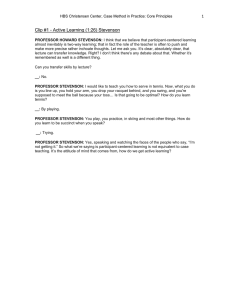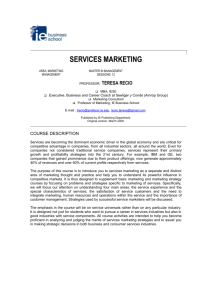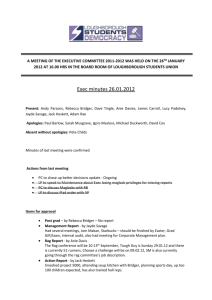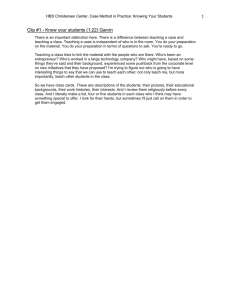Clip #1 - Creating the right climate (2:02) Garvin 1
advertisement
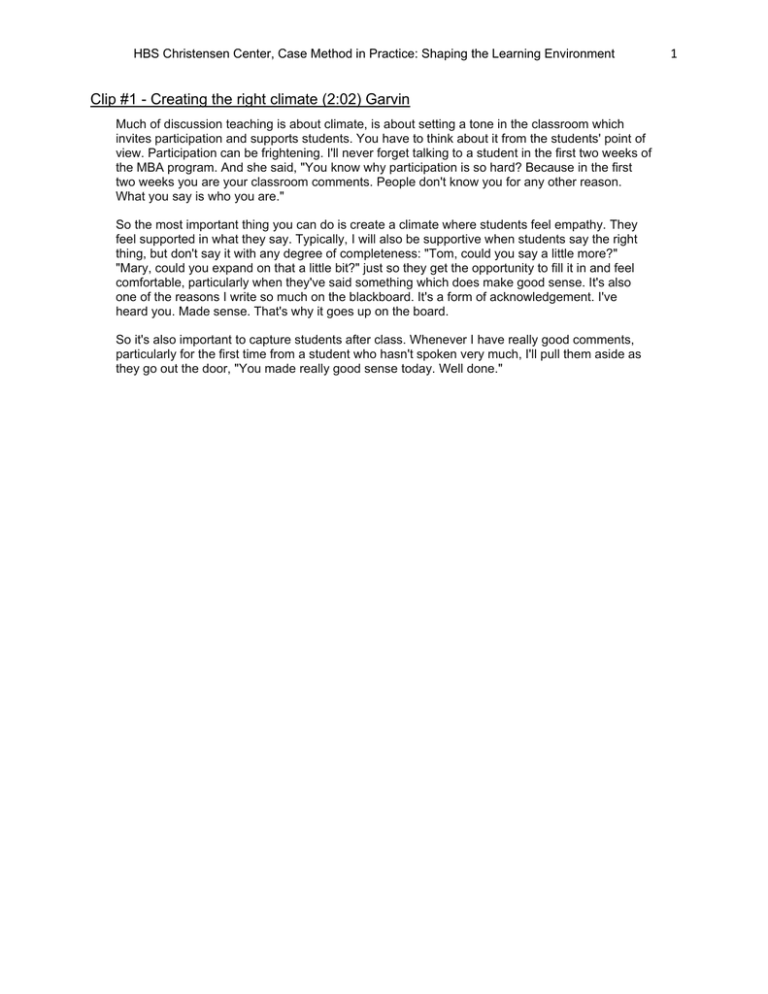
HBS Christensen Center, Case Method in Practice: Shaping the Learning Environment Clip #1 - Creating the right climate (2:02) Garvin Much of discussion teaching is about climate, is about setting a tone in the classroom which invites participation and supports students. You have to think about it from the students' point of view. Participation can be frightening. I'll never forget talking to a student in the first two weeks of the MBA program. And she said, "You know why participation is so hard? Because in the first two weeks you are your classroom comments. People don't know you for any other reason. What you say is who you are." So the most important thing you can do is create a climate where students feel empathy. They feel supported in what they say. Typically, I will also be supportive when students say the right thing, but don't say it with any degree of completeness: "Tom, could you say a little more?" "Mary, could you expand on that a little bit?" just so they get the opportunity to fill it in and feel comfortable, particularly when they've said something which does make good sense. It's also one of the reasons I write so much on the blackboard. It's a form of acknowledgement. I've heard you. Made sense. That's why it goes up on the board. So it's also important to capture students after class. Whenever I have really good comments, particularly for the first time from a student who hasn't spoken very much, I'll pull them aside as they go out the door, "You made really good sense today. Well done." 1 HBS Christensen Center, Case Method in Practice: Shaping the Learning Environment Clip #2 - The learning contract (2:24) Heskett PROFESSOR JIM HESKETT: Do we have a contract here, right now? How would you describe our contract? What words would you use to describe our contract in this class? __: Controlled exchange. PROFESSOR HESKETT: Controlled exchange, OK. __: Mutual respect. PROFESSOR HESKETT: Mutual respect. __: Reflection. PROFESSOR HESKETT: Reflection, OK. Ricardo? RICARDO: Common objectives. PROFESSOR HESKETT: We have common objectives. __: Eagerness to learn. PROFESSOR HESKETT: Eager to learn. We’ve only been together now for a portion of two classes, right? Is it possible to have a contract that quickly with a class? Do you know? Do you think? How quickly do you think the contract is formulated quite often? At what point does our class begin to evaluate our contract? __: Sixty seconds. PROFESSOR HESKETT: Sixty seconds! Almost immediately, immediately! That’s why the first day is so important. It’s precious. How many times have you heard a colleague say, “Well, the first class is all about administrative matters. It’s kind of a throwaway, you know. It doesn’t count.” Jeff just said it counts. It counts. And it begins counting about sixty seconds into the class. Several of you have said it starts counting before the class starts because we have expectations that are either fulfilled or not, even though we may not be able to know exactly what that contract is until we’ve seen the behavior in the classroom and, I suppose, the instructor’s reaction to that behavior. 2 HBS Christensen Center, Case Method in Practice: Shaping the Learning Environment Clip #3 - Explicit/implicit contract (4:10) Heskett PROFESSOR HESKETT: Do we prefer an explicit or an implicit contract? __: Explicit. PROFESSOR HESKETT: Explicit? __: Yes. PROFESSOR HESKETT: What do you expect of me, and what do I expect of you. That would be an explicit. Aurea? AUREA: If it doesn’t match with the implicit contract, it doesn’t matter. You say something and you behave in another... PROFESSOR HESKETT: It had better match with the implicit contract. Some people would say, “I’d rather stick with an implicit contract, so that every time I step to this point in the classroom, the class understands that it’s now my time to say something.” We had a colleague with whom I taught for several years—a fellow named Tony Athos, who passed away recently. And Tony would always step to the same spot in the classroom when he wished to give a short lecturette—maybe five minutes of summary. And after three or four of those experiences, the class implicitly understood that this little spot right here was Tony’s. Everything else in the room might have been theirs, but this was Tony’s. And the class would quiet down, and he would give a five- or ten-minute set of comments. And I tried to exhibit some of that behavior. Some of the rest of us have concluded that perhaps it’s important to communicate the idea that the entire room belongs to all of us, right? So that you have no private activities, no private thoughts back here in the back row. Whatever is on that computer screen back here is mine as well as it is yours, that sort of thing, so that you influence behaviors in ways that everyone understands, after you’ve made the second or third trip through the back of the room. So it depends, I suppose, on our preferences. Some of us would feel more comfortable discussing these ideas with the class, and particularly talking about our expectations. Some might prefer just to demonstrate implicitly with our behaviors in the classroom. Because the body language that we use conveys a lot, it seems to me, about our interest in what we’re talking about, the level of concern that we have for preparation, the respect that we have for each other, and for the ideas that are placed out in front of us in the classroom. And that can be conveyed very, very quickly. Whether we have organized in some way so that we have at least a general idea of where the discussion might go—something that we can often communicate through our blackboards. And you have several other instructors in this course who are masterful at the blackboard. I wouldn’t pretend to try to emulate what they do in helping to shape discussions at the blackboard. 3 HBS Christensen Center, Case Method in Practice: Shaping the Learning Environment Clip #4 - Helping students prepare (1:12) Garvin The first thing to keep in mind is whether or not students are at all familiar with case method. If they're not, you need much more elaborate instructions. The first requirement is to let them know they carry the load. It's not the instructor standing up there and giving them little tidbits, and then them following up. It's their carrying the flow of discussion, in large segments—fifteen, twenty, thirty minutes at a block. The second is to let them know that they are preparing answers to assignment questions, but answers that don't necessarily have an easy right or wrong. They may be asked to make a choice. They may be asked to flesh out a position. They may be asked to present a point of view. So they need to be prepared to argue their case. And the third is they need to recognize they'll never get it all. If you try to cover everything in your case preparation, it's five, six, seven hours. It takes instructors sometimes ten or twelve hours to do their first prep of the case. So you want your students to be a little bit calm about the missing pieces in their preparation. 4 HBS Christensen Center, Case Method in Practice: Shaping the Learning Environment Clip #5 - Am I in or am I out? (1:20) DeLong PROFESSOR DELONG: It’s the "inclusionary" dimension. And this is the one that’s most important to your faculty and it’s most important to my students—I have ninety students. The inclusionary dimension; do you have a sense of what that is? The question that every student asks here and that your faculty ask is, am I in the club or out of the club? Am I in or am I out? That’s what we worry about, am I in or am I out? We know, just like all ambiguous behavior is interpreted negatively, there is a constant gravitational pull towards people to feel left out. That is the human condition. You’ll see it with little people, and you’ll see it with big people. They start looking where they are feeling left out. You see that. My goal, as soon as possible as a teacher, is to convince all ninety students that they are in the club. 5
